Telegraph Offices in the Central West region.
- Australia 1901-1988
- New South Wales
- Overview of NSW
- Telegraph lines
- Telegraph Offices
- Date stamps
- Forms
- Envelopes
- Instructional annotation
- Collect
- Delayed
- Free
- Immediate Urgent
- Reply paid
- Rates
- Stamps
- 1871 Telegraph stamps
- 1885 proposal
- 1893 proposal
- Queensland
- South Australia
- Tasmania
- Victoria
- Western Australia
- International
- Special aspects
The Telegraph Offices constructed in the Central West region of NSW are listed in the table below:
|
A Post Office was established at Alicktown on 1 December 1889 in lieu of the receiving office known as Bachelor's Rush. The Post and Telegraph Office opened on 2 July 1891. The Gazette of 15 July 1891 announced that the Post and Telegraph Office now known as Alicktown will bear the designation Alectown as from 1 July 1891. Personnel: June 1891: Mr Percy David Brown was appointed as Post and Telegraph Master at Alicktown. He was transferred from Peak Hill (further information there). |
| Barmedman.
In the Legislative Assembly on 16 April 1868, £1,600 was placed on the Estimates for the construction of a Telegraph Station at Barmedman In 1874, gold mining began at Barmedman Reefs which was located on a pastoral property called Barmedman. A Public House opened at Barmedman Reefs in 1878 and other businesss followed soon after. From about 1882, the place was increasingly referred to as Barmedman and in August of that year, Crown land was set aside for "the site of a town to be called Barmedman". In 1903, the railway line was completed from Temora to Barmedman and later continued to Wyalong and Cargelligo. A Telegraph Office was opened on 10 September 1883 and that merged with the Post Office on 1 October 1883. The Post Office had originally been opened when Wyalong changed name to Barmedman on 22 May 1882. The Post Office had originally been opened on 1 August 1876 as Wyalong but the office changed name to Barmedman on 22 May 1882. |
|
|
|
| No special date stamp for use with telegraphs was issued to the Office. The usual postal date stamp was therefore used. H&T Type 1D (i). Diameter: 24 mm.
|
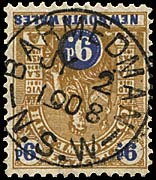 2 July 1908. Used on 9d Commonwealth issue which could be used to pay the cost of a 16 word ordinary rate telegram to a destination within NSW. |
| Bathurst.
On 17 September 1859, the Bathurst Free Press reported that A Telegraph Office was opened on 29 December 1859. On 4 January 1860, the Northern Times reported that, as of 30 December "The excitement occasioned in this town by the opening of the telegraph still continues. The telegraph office was crowded all day by persons sending messages and the promptness with which the replies were received has given great satisfaction". |
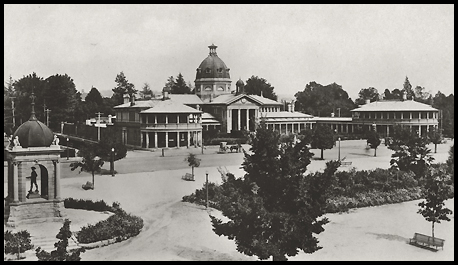 The Government Buildings in Bathurst. Central one is the Court-House. On the left is the Post & Telegraph Office. |
Time Ball. Immediately (2 days after opening) there was a call for a Time Ball in Bathurst - even before they had thoughts about a Telegraph Office. One can always improvise in most things - and here a post would do to overcome "the great inconvenience to which the inhabitants of this town, whether engaged in business or otherwise, are continually exposed, in consequence of the very material difference which almost ever exists between the various public clocks. The opening of the electric telegraph in Bathurst affords an excellent opportunity of remedying this inconvenience, for we are informed by the Superintendent, Mr. Cracknell, that, sbould the inhabitants of the town think proper to provide the necessary apparatus, which is of the very simplest description, the authorities at the Telegraph Office would ensure the daily notification of the correct Sydney time at mid-day. We believe that all that is required is a pole with a ball, which could be raised, by way of signal, a few minutes before 12 o'clock, and dropped when it reached that hour by the Sydney time. We cannot imagine that a desideratum so essential and so easily supplied will long remain in abeyance" (Ballarat Free Press 31 December 1859). The Telegraph Office. Tenders were called in the Gazette of 13 July 1860 for the erection of an Electric Telegraph Station at Bathurst with a closing date of 24 July.A tender for a new Telegraph Office was accepted on 14 August 1860. The SMH of 22 October 1860 elaborated on this announcement about the Telegraph Office: "Several new telegraph stations are in progress or about to be proceeded with, the courthouses having hitherto been used for that purpose in the towns through which the wires have been carried. New stations have been commenced at West Maitland, Newcastle, Windsor, Albury, Goulburn, Bathurst, and Yass and others will soon be put up at Gundagai, Hartley and Wollombi. The buildings are nearly all upon one plan consisting of five rooms including a residence for the station master". Even so, during the discussion of the Estimates on 21 February 1861, Mr. Rotton noted: "Lower down there was £15,000. It is also used as a telegraph office. The present building was only sufficient for the business of the police-court. The Government ought to build a new court house in the town. He also asked the Minister for Works whether a Post Office, with Telegraph Office, was to be built in the town? This was promised to the late member for Bathurst (Mr. Cements.) He saw £600 for a Telegraph Office at West Maitland, which had not been promised". |
|
|
|
It did not, however, combine with the Post Office until 13 November 1905. The Post Office had been opened on 1 March 1828 - one of the earliest in New South Wales. A very full account of the Post Office together with a picture from the right side was written by the Bathurst District Historical Society. A new Post Office building was completed in June 1864 by renovating the premises previously occupied by the Joint Stock Bank. Tenders for the erection of a new Post & Telegraph Office at Bathurst closed on 2 February 1875. On 28 April 1875 in the Legislative Assembly, Mr. F, B. Suttor asked the Secretary of Works:
In the Legislative Assembly of 20 March 1878, Mr. Parnell, in reply to Mr. Webb, said the Road Superintendent had that day been instructed to give up possession of the old telegraph site at Bathurst to the Council of Education. Personnel: May 1861: Mr. W. T Wye was appointed Line Inspector. November 1862: Mr. F. Mackel, formerly at Braidwood, was appointed Line Inspector but was then transferred again in January 1863 to be Line Inspector at Young. January 1863: Mr. John Buckle was transferred as Line Inspector at Forbes to be Line Inspector at Bathurst. 1 July 1871: Mr. Robert S. Johnson appointed Junior Operator. January 1876: Mr. John P. Gallagher, Telegraph Operator at Bathurst was appointed as Station Master at Molong. January 1876: Mr. Richard Matthew Reid was appointed as Junior Operator in lieu of Mr. Gallagher. May 1881: Mr. A. J. Hoskisson, a Junior Operator at Bathurst was promoted to be Operator at Bourke.
August 1881: Mr. H. C. Whittaker, Telegraph Master at Blayney to be operator at Bathurst. May 1889: Mr. J. M. Hackett left Bathurst Telegraph Office to take charge if the Post and Rockley Telegraph Station. |
|
Bathurst was one of the 29 Telegraph Offices included in the special printings of delivery envelope NC-EO-3. These envelopes incorporated an embossed oval seal (EO6-ET) on the flap of the envelope with NEW SOUTH WALES at the top and ELECTRIC TELEGRAPH at the base. The office name was embossed across the centre of the seal.
|
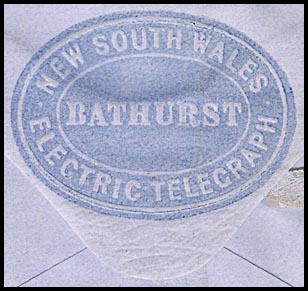 Scan of embossed oval on flap of envelope. Provenance: De La Rue Archives, Gundersen, Johnstone. |
| A Telegraph Office was also opened at the Bathurst Racecourse on 24 January 1914 and operated (on race days) only until 1966. | ||
Two types of date stamp were used with telegrams:
|
||
Used: 3 October 1944 to 1965. |
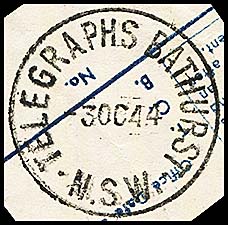 3 October 1944. (Earliest recorded date). |
 14 November 1945. Used on AB-DO-8H. |
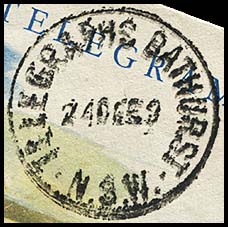 24 December 1959. Used on FDI Xmas envelope (AA-GXE-59). |
||
|
Tenders were called for the erection of a Post & Telegraph Office at Blayney in August 1879. In the Gazette of 2 October, 1879 Donald and Craw were announced as the successful tender. August 1881: Mr. C. F. Studdert, Junior Operator and Postal Assistant at Gloucester to be Station Master at Blayney replacing Mr. H. C. Whittaker who had been transferred to Bathurst. |
|
The Post Office at Booligal had opened on 1 March 1861. "The Government have advertised for tenders for telegraph extension from Hay to Booligal, to be completed in four months from date. We have no post-office here to convert into a Telegraph and Post Office when the wire reaches us. I hear that a site has been partly fixed upon for that important office. The Government would confer a great favour by giving us a building worthy of the name. These offices, combined with a sadly-mourned-for Savings Bank would give at least two officials sufficient work. We have no bank here, consequently the labouring portion of the community around here have no inducement to treasure up their savings. We have one Government building, the court-house and lockup very unpretentious in appearance. The Hon. Postmaster-General could not give Booligal a more acceptable Christmas-box for 1877 than a building combining the three offices referred to. Booligal is important, not only as being on the proposed line of railway extension to the Darling, but also as a postal town. The mails to Bourke, Hillston and Wilcannia are made up here, causing hard work to the officials, who often seek "sweet, balmy sleep" just before the dawn of day. At present the Post Office is connected with a store here, but the large Government business done warrants a separate building. Although the country for miles either side of us is in a most deplorable state, it is astonishing to see the number of travellers passing through. The mail coaches have been tolerably well filled lately, but last Sunday, the 22nd April a special coach had to be put on from Hay to Booligal - the mail and special bringing a total of twenty-nine passengers. I am informed that ten passengers had to be left behind in Deniliquin" (Sydney Morning Herald 5 May 1877). An insight into the state of communication in Booligal was printed in the Sydney Mail on 13 April 1878: "Through the heavy state of the Deniliquin road the Sydney letters came to hand seven hours late. Through the courtesy of the postmaster, Mr. Chambers, when the mail arrives in good time we obtain our letters, &c, a few hours after arrival. This gives us the opportunity of replying by return mail next morning; but when, as last mail, we get the letters the following day too late for return mail, causing a delay of three days. In the absence of the telegraph, the above delay is inconvenient, as well as a pecuniary loss to business men. There is some talk of our having a tri-weekly instead of a bi-weekly mail. In reference to this all I can say is, the sooner the better for horses and travellers. Frequently 16 passengers are crowded on an 11 -passenger coach or 20 on a 14-passenger coach.. Such loading, though necessary at times, is a tax on travellers' patience and cruel to the horses — although Cobb and Co. horse the Hay line fairly". The Telegraph Office opened on 1 July 1878 - in temporary accommodation obviously. Fresh tenders for the construction of a Post and Telegraph Office at Booligal were called in the Gazette of February 1881. In April, the tender submitted by Mr. J. Witcombe to construct the Post and Telegraph Offices was accepted. |
|
Changed name from Burrowa on 1 December 1914. A Post Office had opened on 1 July 1854 in Cox Bros. Store. The telegraph connection was opened to Burrowa by Mr. Cracknell on 19 December 1866. The telegraph facilities were located in a room placed at the disposal of the authorities by Mr. T. B. Gibbons. The Yass Courier of 1 July 1868 reported as follows: "A good deal of surprise wns shown by the inhabitants of East Burrowa on its being made known that the Post Offioe is to be transferred on the 1st prox. to the other side of the creek. The advisability of the step belongs more to tho public than to an individual to pronounce upon, and is certain to cause dissatisfaction, no matter at which end it is placed, so long as the reserve of discord is allowed to divide the township. Mr Beattie, Telegraph Master, is to conduct the amalgamated duties of Post and Telegraph office from 1st July". Officially however, the two offices were amalgamated on 1 January 1870. At the time of the change of office location, the Yass Courier of 11 July 1868, printed a letter to the Editor which addressed the nature of the location but also the broader principles of Post and Telegraph Office operation and location. Well worth the read. It was not long before there was a big difficulty. The Gouburn Herald of 1 August 1868 described the problem which arose in Burrowa nearly 15 months after opening - see elsewhere: Very soon after - in March 1874 - the site for the new Post and Telegraph Office for Burrowa was pegged out by two officials of the Works Department (Evening News, 16 March 1874). In a report of travelling from Wagga Wagga, the Sydney Mail of 7 March 1874 quotes its correspondent as saying "Burrowa seems as dull as a place could possibly be, although centred in a fine district. To me, as a visitor, it appears as if there were too many business people and not enough business. I also fancy there is a want of union or co-operation". On 28 April 1874, the Yass Courier reported: "The new Post and Telegraph office building (at Burrowa) has not yet been commenced. I see a telegram has been sent to the Herald stating the contractor has received instructions to proceed and that universal indignation was felt by a large number of the inhabitants for the government to build it in such an out of the way part of the town; and another telegram appears in the Evening Post refuting the one in the Herald. Whichever is right, one thing is certain - that it is not the proper position as it is not central by a very long way and also, that by far the greater portion of the townspeople are indignant at such an injustice being perpetrated upon them". The frantic pace of change continued unabated and, on 7 April 1876 in the Legislative Assembly, Mr. Burns (the Postmaster-General) said, in answer to Mr. James Watson, that "the Post and Telegraph Office at Burrowa was reported as completed on the 6th April, so far as the building was concerned. The necessary fittings were being provided and the new office would be occupied in a few days". Personnel: October 1866: Mr.Albert E. Middleton was appointed Station Master. November 1867: Mr. James M. Beatty was appointed Electric Telegraph Station Master at Burrowa. February 1874: Mr. J. R. Colls was appointed telegraphic Station Master to replace Mr. A. E. Middleton who had resigned. Mr. J. Colls is the son of Alderman Colls of Burrowa. "The salary, we believe will be £200 per annum. Mr. J. R. Colls is at present stationed at Deniliquin but, as soon as the staff at that office is at full strength (two of the assistants being now absent on leave), he will proceed to Burrowa. December 1874: Mr. Daniel Ryan Kenane was appointed as Station Master in lieu of Mr. Colls. Mr Kenane had previously been Station Master at Jereelderie. May 1881: Mr. D. J. Elliott, a junior operator at Young was promoted to be Station Master at Burrowa to replace Mr. Kenane. |
Burrowa was one of the 29 Telegraph Offices included in the special printings of delivery envelope NC-EO-3. These envelopes incorporated an embossed oval seal (EO6-ET) on the flap of the envelope with NEW SOUTH WALES at the top and ELECTRIC TELEGRAPH at the base. The office name was embossed across the centre of the seal.
|
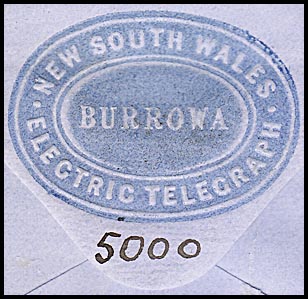 Scan of embossed oval on flap of envelope. Provenance: De La Rue Archives, Gundersen, Johnstone. |
|
The telegraphic connection opened at Carcoar on 10 November 1870. In the Gazette of April 1877, tenders were called for the erection of a Post and Telegraph Office at Carcoar - closing 17 April 1877. In April, 1870 the Bathurst Free Press reported "Easter Monday passed over at this dull place (of Carcoar), as all other days in the year do without any amusement of any kind. There was not as much as a cricket match, or a foot race to amuse the inhabitants of this town. The only amusement we have had during the year being the Presbyterian annual tea meeting and now the Church of England tea meeting and the bazaar in aid of the Roman Catholic Church, all of which were well patronized by the residents of the district, and were of great assistance to the institutions which they were intended to benefit". During a heavy thunderstorm in January 1876, "between 1 and 2 a.m. the electric fluid entered the telegraph office, causing considerable damage in fusing the instrument and wires , also setting on fire a number of papers, which was fortunately discovered in time by Mr. Hosking - the Station Master - to save the building". Personnel: September 1892: Mr B. J. Martin, late Post and Telegraph Master at Wanaaring, was transferred to the corresponding position at Carcoar. |
| Condobolin.
The Telegraph Office was opened in 1878 and merged with the Post Office on 21 August 1878. The Post Office had opened on 1 July 1858. Condobolin is 467 km from Sydney.
|
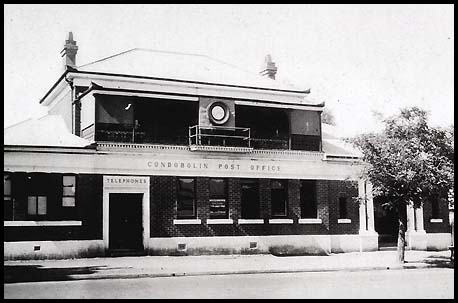 |
|
| A rubber circular TELEGRAPH OFFICE date stamp was issued to Condobolin. Has N.S.W. after the town's name at the base. |
||
|
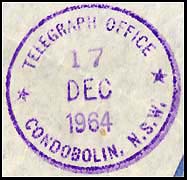 17 December 1964. Used on AA-DO-13B.
|
|
| Coonamble.
The Coonamble Telegraph Office was opened on 20 July 1875 and merged with the Post Office on 1 September 1875. The Post Office had opened on 1 April 1859.
|
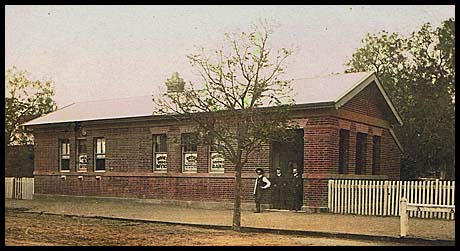 Coonamble P&T office about 1880. |
Tenders were called in April 1979 for the construction of a new Post & Telegraph Office. Clearly the Maitland Mercury (29 June 1879) considered there was a need for a new office:
In February 1881, the Post & Telegraph Office moved into its new building "although no fence had yet been erected between the Post Office yard and the gaol". Personnel: July 1876: Mr. Charles Fry, Telegraph Master at Coonamble exchanged positions with Mr. Thomas H. Ryan of Dungog. July 1878: Mr. Luke Kingmill, then a junior Operator at Glen Innes, was appointed Station Master. November 1878: Mr. James S. Page was appointed as Junior Telegraph Operator. August 1881: Mr. Henry Burton, probationer at Mount Victoria, to be Junior Operator at Coonable, vice Golding. October 1885, Mr. W. H. Datson, telegraph messenger at Girilambone, was appointed as the Telegraph Operator at Coonamble. March 1890: Mr Claude McCullough Ireland was promoted from Telegraph Operator at Burwood to Postal Assistant and Telegraph Operator at Coonamble to replace Mr. Datson. |
|
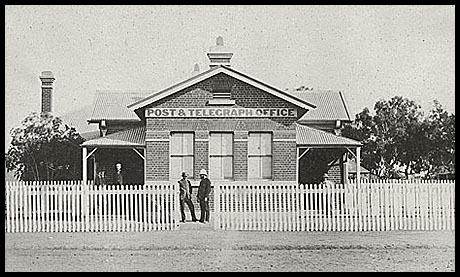 The new Coonamble P&T office in 1884. Source: NSW State Records. |
Source: NSW State Records. |
A steel circular Type 2C TELEGRAPHS COONAMBLE date stamp was used both on telegrams and on ordinary mail.
|
|
 Cover with a Coonamble Telegraphs date stamp of 28 May 1936. The cover commemorates the first air mail flight between Coonamble and Sydney. |
|
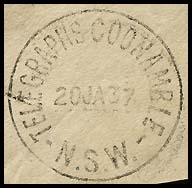 20 January 1937. |
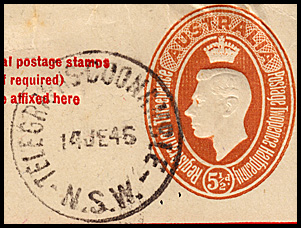 14 June 1945. Used on an embossed registration envelope. |
| Cootamundra.
The Telegraph Office at Coramundra had opened on 31 May 1875 while the Post Office had opened on 1 August 1864. A combined Post & Telegraph Office at Cootamundra was opened on 1 July 1877 when the previous office of Coramundra changed name. The nature of the office is unknown - and possibly temporary - because in July 1878, tenders were called for the erection of a Post and Telegraph Office at Cootamundra - closing 13 August. In the Supplementary Estimates for 1879, £400 was allocated for the construction of a Post & Telegraph Office at Cootamundra. Tenders were again called in the Gazette in August 1879. |
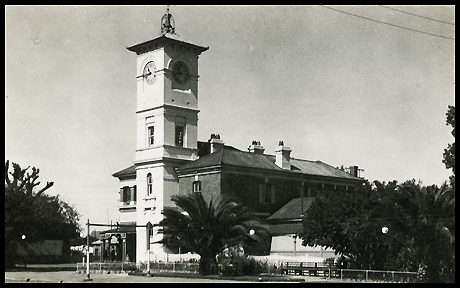 Cootamundra Post & Telegraph Office. |
1882 was an important year:
The need for a horse at Cootamundra can be read elsewhere. It is unlikely that the Cootamundra telegraph office was opened in anticipation of the birth of the great cricketer Sir Don Bradman some 30 years later !!! :) Personnel: November 1879: Master W. Parker (eldest son of Sergeant Parker), who had for the past three years been engaged as probationer of the local Telegraph Office, was been promoted to the Wentworth office, where he was to fill the duties of junior operator. |
|
A steel circular TELEGRAPHS COOTAMUNDRA type 2C date stamp was issued to the Office.
|
|
|
The Telegraph Line was completed to Crookwell from Bathurst in March 1880 but it appears that the telegraph Office in Cox Bros.' Store did not open until 19 May 1880. The Post Office had operated from that Store since 2 September 1867. |
|
The Evening News of 6 May 1886 reported that "Arrangements are being made for holding public meetings in the Molong district to agitate for the extension of the railway to Cumnock and also for the erection of a telegraph line to that place". A Post Office had been opened in Cumnock on 1 August 1879. In the Legislative Assembly of 10 July 1890, "Mr. O'Connor, in reply to Dr. Ross, said the question of erecting a Post and Telegraph Office at Cumnock could not be decided until that of opening an official Post and Telegraph office had been determined and the reports called for on the latter question were not yot to hand". The Molong Express of 23 August 1890 raised great hopes: "Cumnock is at last to have a telegraph office, and not a day too soon. An advertisement in another column calls for tenders for erecting an additional wire from Molong to Wellington and also a line therefrom to Cumnock. The next, thing is a court of petty sessions, instead of a man having to be dragged in nearly 20 miles to Molong for perhaps being drunk or speaking the 'classics'" Alas, with the passage of several months, it was decided 'by the Report' that no telegraph station but a Telephone Service at the Post Office was to be established - on 6 February 1891. That enabled telephone and telegraph services to be transacted. For reasons now unknown - except possibly for the realisation of the greater importance of telegraphs - the Telephone Service was replaced with a Telegraph Office on 13 July 1899. On 22 July 1899, the Leader noted "Mr. James Say, Acting Post and Telegraph master here for the last few months has gained the respect of the townspeople to such an extent that they have sent a petition signed by over 60 residents to the Postmaster-General praying for his permanent appointment. The Postmaster-General sent a reply but did not grant the appointment. As Mr. Say is a young bachelor, probably a married man may be more entitled to the position". A follow up to this report was printed on 28 July 1899 in the Molong Argus: "Mr. James Say, Post and Telegraph Master at Cumnock, is to be transferred and Mr. G. Black is to succeed him. Doubtless our Cumnock friends will be surprised to hear this. We are. Mr. Say is certainly to be transferred, but it is hardly likely the Department will appoint as his successor a young gentleman who is fortunate enough to have kept clear of Government drudgery so far". The Wellington Times of 10 August 1908 upadted its readers with: "An examination is to be held here at Cumnock on Saturday for candidates to fill the position of telegraph messenger at Cumnock. Two candidates from here sat for examination at Molong last week for postal assistants. The results are not yet known". Personnel: September 1908: Master 'Jack' Hembrough of Molong has taken up his duties as telegraph messenger at Cumnock. He received the highest marks in the competitive examination noted above. |
|
The Post Office at Dalton was opened on 1 May 1863. The Telegraph Office opened on 22 August 1892 and merged with the Post Office the following day. |
|
 Dalton PO with no sign of telegraph so the photo was probably taken before the 1890s. |
|
|
A Telegraph Office was opened at Denman on 6 October 1868 "for the transaction of telegraphic business under the guarantee system". Personnel: 3 November 1868, the Gazette announced the appointment of Mr. George A. F. Kibble as the Electric Telegraph Station Master at Denman. March 1890: Eliza de Trevana was promoted to be Post and Telegraph Mistress at Denman. |
|
The Telegraph Office was opened (somewhere) on 12 November 1864 and merged with the Post Office on 1 September 1867. In July 1871, a petition was delivered to the Government asking for an assistant to be provided to the Telegraph Master with the duties to look after postal matters. The Post Office had opened on 1 January 1848. |
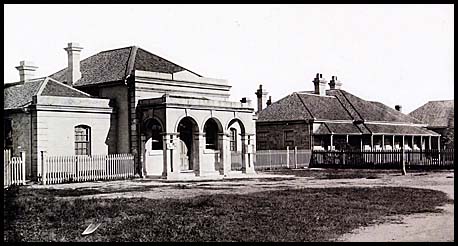 First Dubbo Post & Telegraph Office. |
|
|
||
The Australian Town and Country Journal of 4 September 1886 reported "The new post and telegraph offices (possibly those shown in the above image) are nearly completed and they will probably be occupied in about four or five weeks. This will not be a day too soon. In comparison with other offices, the Postmaster-General's report for the year 1885, just issued, shows this to be about the best paying office in the colony". Somtimes, no matter the quality of the design of the construction, little things can and do go wrong. The Dubbo Liberal of 13 September 1921 reported "The post office clock has not exactly been adopting the go slow habit recently but has actually refused to go at all on two occasions. People who rise with the 6 o'clock chime every morning waited in vain yesterday as the old timekeeper stopped at 4.30 and there were a few who overslept themselves". November 1866: Mr. Alfred Hayes was appointed Station Master. June 1875: Mr. Thomas Channon, formerly of Deniliquin, was appointed to be Station Master at Dubbo to replace Mr. Aldwell who had died. 1896: Mr. H. Curry was transferred from Braidwood to Dubbo as Station Master. He remained there for 9 years before transferring back to Goulburn. See the Goulburn entry for further details November 1925: Mr. J. Miles, Manager of the Telegraph Office at Dubbo was appointed Postmaster at Griffith. Mr. Leslie became Acting Manager of the Telegraph Office at Dubbo. |
||
|
|
||
|
A steel circular type 2C TELEGRAPHS DUBBO date stamp was issued to the Office for use on telegrams as well as for other purposes. This type has a full-stop after the W. A type 2A (no full stop after the W) was apparently used between 1915 and 1921 on telegrams. |
||
|
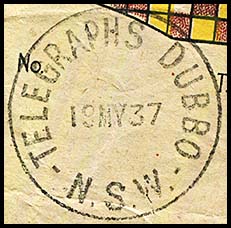 19 May 1937. Used on AB-GCF-36A. |
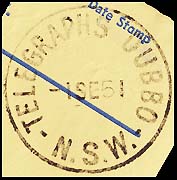 1 September 1951. Used on AB-GCF-36A. |
The only TELEGRAM slogan cancellation recorded as having been used at Dubbo is TELEGRAMS: SPEEDY, RELIABLE, EFFECTIVE. The only recorded example of its use at Dubbo is on 15 May 1941.
|
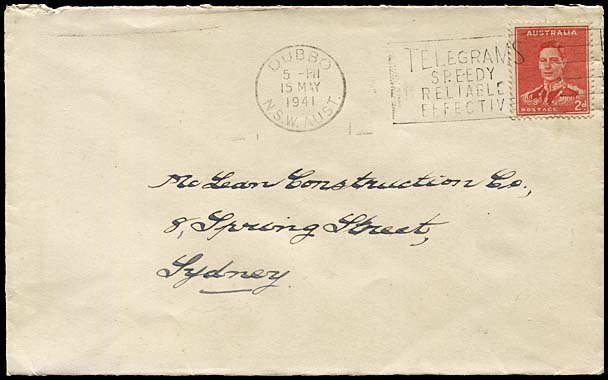 15 May 1941. |
|
| Forbes/ (The Lachlan).
The Forbes Telegraph Office opened on 27 October 1862 and merged with the Post Office on 1 January 1870. On opening day, the results of the three days of races at the Lachlan Gold Fields were telegraphed to Bathurst. The Post Office had been opened on 1 December 1861 and given the name Black Ridge in response to the demand for postal services by those involved with the gold rush along the Lachlan River. That name was changed before opening although the first canceller did use the name Black Ridge for a few weeks. Forbes was also often referred to as "the Lachlan". |
 Forbes Post Office - designed by the Colonial Architect James Barnet. This building opened on 8 September 1881. Servants' quarters and stables were at the rear. |
|
|
||
In the Legislative Assembly of 30 May 1862, Mr Weekes stated in answer to a question from Mr. Wisdom that "it was not intended to extend the present postal accommodation at Forbes, on the Lachlan, otherwise than by the erection of a new post-office in connection with the telegraph office". The Gazette of 11 July 1862 noted that the tender submitted by Mr. Peter Graham for the erection of a Telegraph and Post Office at Forbes had been accepted. In September 1862, a reef was opened behind The Observer office in Forbes and gold was discovered. The Bathurst Free Press of 1 November 1862 questioned how Forbes could continue to exist with such a large population yet no gold being exported, etc. The Pastoral Times of 2 April 1870 printed a traveller's tale in which it is said "Forbes itself presented all the appearance of a place that had been thrown together by chance. The irregularity and narrowness of the streets struck me forcibly if I might accept the Courthouse square—not but Forbes has some good buildings: the Court-house, well enough in its way; the Mechanics Institute, a nice little structure; the Telegraph and Post Office, right enough; the two banks and Thomas' new store, certainly worthy of a thriving town". In November 1878, a tender was accepted from Mr. R. M. Vaughan for the erection of a Post and Telegraph Office at Forbes. The Maitland Mercury of 25 September 1866, citing its Lachlan Reporter, revealed an interesting twist to the Forbes' personnel: "In consequence of Mr Atkyns, the Postmaster, not making his appearance at the Post Office on Monday last as usual, inquiries were set on foot which led to the discovery that he had started by the mail coach on the Sydney Road that morning. The authorities in Sydney were subsequently communicated with by telegraph, and on Friday the police received instructions to take charge of the office. Up to the time of going to press this morning, no further definite information had been received respecting Mr. Atkyns' movements than that he had travelled by coach as far as Bathurst, where it appears he was lost sight of last evening. Mr. Thompson of the Bathurst Post Office arrived by coach to relieve the police of their charge. This is all that can be said with certainty of this unfortunate circumstance at present, but possibly the coming week may throw some further light on the mystery with which it is at present surrounded". November 1862: Mr John Buckle was appointed line inspector but was transferred in January 1863 to be line Inspector at Bathurst. May 1867: Mr Alfred Tunks, now Station Master and Line Inspector at Forbes, was appointed Station Master and Line Inspector at Penrith.
May 1868: Mr. Edward H. Allen was appointed Electric Telegraph Station Master; ??: Mr. Robinson was the Postmaster and Telegraph Master at the time of the amalgamations. He was transferred to Deniliquin for a short time in March 1870 before being retrenched. July 1883: Mr. George Lobsey who had been Chief Operator at the Forbes Telegraph Station for six years was transferred to Pooncarie. He "was presented last night with an address and a splendid chronometer watch by his numerous friends. Mr. Raymond, Mayor of Forbes, made the presentation, and spoke in eulogistic terms of the character of the recipient". June 1891: Mr. Clifford was transferred to Peak Hill to replace Mr. O. Brown as Assistant Post Master. October 1918: Mr Dick Burgess, who had been relieving at the G.P.O., Sydney for the past three months, resumed duties at Forbes telegraph office. July 1925: Mr. Ernest Jones, telegraph linesman in Forbes for a number of years, was last week transferred to Parkes. He is a married man and will be making his home in Parkes in the near future. |
||
|
The earliest evidence of the operattions of the Forbes Telegraph Office is the printing of the de La Rue telelegram delivery envelope for Forbes - albeit about four hyears before the Telegraph Office opened at Forbes. |
||
Forbes was one of the 29 Telegraph Offices included in the special printings of delivery envelope NC-EO-3. These envelopes incorporated an embossed oval seal (EO6-ET) on the flap of the envelope with NEW SOUTH WALES at the top and ELECTRIC TELEGRAPH at the base. The office name was embossed across the centre of the seal.
|
 Scan of embossed oval on flap of envelope. Provenance: De La Rue Archives, Gundersen, Johnstone Collection. |
|
|
| The Forbes Railway Station also opened telegraph facilities on 14 September 1894 although these were closed on 22 October 1895. |
Grenfell was one of the 29 Telegraph Offices included in the special printings of delivery envelope NC-EO-3. These envelopes incorporated an embossed oval seal (EO6-ET) on the flap of the envelope with NEW SOUTH WALES at the top and ELECTRIC TELEGRAPH at the base. The office name was embossed across the centre of the seal.
|
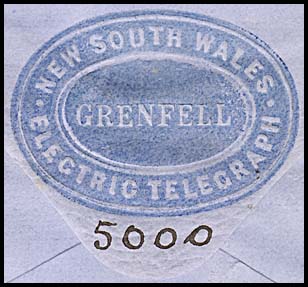 Scan of embossed oval on flap of envelope. Provenance: De La Rue Archives, Gundersen, Johnstone. |
|
In January 1882, the tender submitted by Mr. Witcombe for the erection of the Post and Telegraph Office at Hillston was accepted. The staff of the Office consisted of the Post and Telegraph Master and an assistant. The Hillston News of 10 February 1883 described the new Post Office in the following way: "This building is now approaching completion. The plasterers have finished their part of the contract, and last Wednesday took their departure for Hay. All the rooms inside have had three coats of plaster, the last and finishing touch being done in the early part of this week. The public office is colored in French grey, the passages in buff, the dining and sitting rooms in pink, and the bedrooms in buff; and they all look to be neatly finished. The mantel pieces are of white marble and polished slate respectively. The name on the outside facing towards Molesworth Street are raised letters, in cement, four inches in length, with the words, "Post and Telegraph Office". The chimneys and window sills also being cemented. The carpenter and painter have been following the plasterers up through the different rooms, and they expected to have the place ready for the Postmaster to go into in about a fortnight's time But the carpenter, having been taken suddenly ill and incapacitating him from work, may not be able to hand the keys over as soon as was first thought". On 24 March 1883, the Hillston News continued the story: "We are glad to inform our readers that this building is finished and the appliances were removed into it on Sunday last. This is a great comfort to the public, and also to Mr. Bellamy and his assistant, who are deserving of great praise for the way in which they managed all their business in the little "sweat-box" they have just left. There are few towns where there are less complaints about the Post and Telegraph offices than in Hillston. We have been, requested by the postmaster to inform the public that, in future, the usual post-office hours will be adhered to and the office closed at 6 o'clock p.m. except on Tuesdays and Saturdays, when it will be open from 7 to 7.30 p.m., for the delivery of the down-river mails". Personnel: May 1898: Mr. Patrick Thomas Whealey, formerly Post and Telegraph Master at Menindie was transferred to a similar position at Hillston to replace Mr. Arnott. |
| Katoomba.
The Telegraph Office opened in 1881. A Receiving Office had been opened at the Railway Station on 1 February 1879 and upgraded to a Post Office on 16 August 1880. The combined Post & Telegraph Office was opened on 19 May 1885 and removed from the Railway Station on 16 August 1885. |
|
The Office was issued with a rare steel circular T. O. date stamp - one of only two Offices to use such a format.
|
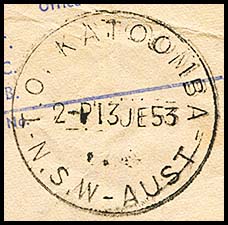 13 June 1953. Used on AW-DO-10 (47BB). |
Personnel: August 1892: Mr. McFadden, the Station Master, was transferred to Trundle. |
|
| Lithgow.
The Telegraph Office was opened 27 February 1877.
|
||
The Office was issued with a circular rubber TELEGRAPHS SECTION date stamp (RC1 - TS).
|
 19 September 1975. Used on a Confirmatory delivery window envelope. |
 28 March 1977. 28 March 1977.Used on a Confirmatory delivery window envelope. |
| The usual postal date stamp was also used for telegraphic business. |  6 June 1942. Used on 1934 Congratulations telegram delivery form AB-GCF-34C . |
|
| Lithgow Hostel.
Lithgow Hostel is about 1 km outside Lithgow and a Telegraph Office was opened there on 27 October 1941. A Post Office opened on 1 April 1942 and a Money Order Office the following week. All operations closed on 21 May 1964. |
||
| A special and rare date stamp was used at the Hostel. It had the preceding letters T.O.K. (Telegraph/Telephone Office Keeper).
Hopson and Tobin record this date stamp as having been used in 1942 to 1957. |
5.jpg) 25 January 1941. Before the Hostel facilities had been opened. |
|
|
Marsden is about 35 km northeast of West Wyalong. A Post Office was opened on 1 June 1866 with the name Marsdens. A Telegraph Office was opened on 1 February 1879 and it combined with the Post Office on 1 April 1879. The name was changed to Marsden on 1 July 1912 and the Office was semi-official. In 1919, the Telegraph Office was changed to a Telephone Office. |
|
|
A Telegraph Office is reported to have been opened on 13 December 1877 but it is more likely to have been early in 1878. It was upgraded to a Post and Telegraph Office on 1 May 1887. The Post Office opened for the fourth time on 16 August 1875. On 20 March 1878, the Sydney Morning Herald reported of a major fire: "About 12 o'clock on Saturday night March 9, a fire broke out (the Burrangongng Chronicle reports), on the premises belonging to Mr. W. Marshall, of Morangarell, and in little over an hour reduced to ashes the hotel, store, kitchen, wash house and stables. The sound of something like an explosion was the first intimation given that anything unusual had occurred. This Mr. Elliott, who has charge of the telegraphic office in the locality, and occupied apartments in the hotel, heard and, rising up in bed to see if he were correct in the opinion he entertained, found that a person was knocking at the door and calling out. As the man did not raise a cry of fire or give any reason for disturbing the house at that hour, Mr. Elliott turned in again but only for a moment as he soon heard a sort of crackling noise that induced him to fear that a fire was in the neighbourhood. His apprehension was but too speedily verified, as on rushing to the front of the bar and looking through the window, he saw nothing but smoke in every direction. By this time the whole household were made aware of their danger, and without waiting to put on any article of dress, they scrambled out into the air through windows and, as best they could, nobody happily sustaining any injuries, save an old man who represented that his head had been scorched. In an hour, the buildings ceased to exist - a circumstance which goes to show what a firm hold the fire must have had on the premises before it was discovered, and the rapid progress it subsequently made. There was a large stock in the store and hotel, every particle of which, being of an inflammable nature, together with nearly the whole of the furniture, was destroyed. It is also said a bundle of notes to the extent of close on £300 met a similar fate, a further proof of the inability of Mr. Marshall or any member of his family to go from one part of the house to the other with any safety. Mr. Elliott did succeed in saving a couch, a few chairs, some bedding and blankets, but all else was sacrificed. Besides Mr. Elliott and three or four other lodgers, there were on the premises at the time of the fire, either in the attics or other rooms, Mr. Marshall, his two daughters, and granddaughter one of whom was lying ill with scarlatina and was in consequence removed with some difficulty. The loss by the fire will be covered to some extent by insurances". The Burrangong Argus of 14 March 1885 reported that "Morangarell, in spite of the numerous bush population, merely supports one hotel, kept by Mr. Child, who was the original contractor of the bridge. This shows the temperate habits of the surrounding farmers because the business would not support two hotels when they were both opened a few years ago ... There is a telegraph office here near the hotel. The operator is a Mr Johnstone, a young gentleman of pleasing manners and manifestly obliging. The post office is at Mr McGregor's station, some 700 or 800 yards from the telegraph office". Personnel: October 1882: Mr. John Johnstone Jnr, Telegraph Officer at Queanbeyan was promoted to be Station Master at Morangarell to replace Mr. Campbell. |
|
The Post and Telegraph Office at Mount Hope opened on 7 October 1884. "Our Post and Telegraph Office is now in full swing. Mr. Page, the Stationmaster, seems a gentleman from whom we may expect civility - which was really much needed" (Australian Town and Country Journal 25 October 1884). On 12 May 1888, the Australian Town and Country Journal reported as follows: "The Mount Hope Post and Telegraph Office is a neatly-built weatherboard cottage with one room set apart for business, and the others occupied by Mr. E. Quince (the postmaster) and his family. Mr. Quince does the whole of the work, with the help of H. Volkman as messenger and assistant. According to a report sent in two months ago to the head of the department by Mr. Quince, Mount Hope proper contained seventy adults and South Mount Hope eighty. At the present time the adult population is as follows: Mount Hope 160, and South Mount Hope 150. If the children are added, the total population may be estimated at something over 400 - the usual proportion between adults and children does not hold good here, as many of the men have left their families elsewhere until they are settled". Personnel: October 1884: Mr. Page was appointed as the first Post and Telegraph Office Stationmaster. July 1887: Mr. E. Quince who was the Postal Assistant and Telegraph Operator at Booligal was promoted to be the Post and Telegraph Office Stationmaster at Mount Hope. |
| Mudgee.
On 10 December 1860, the Legislative Assembly was informed that tenders had been called for the construction of a Telegraph Office in Mudgee. A Telegraph Office was opened on 16 May 1861. "The extension of the electric telegraph line to Mudgee was opened yesterday (Friday), and the following message from the Honorable the Secretary for Public Works was exhibited outside the office: "Mr. Secretary Arnold congratulates the inhabitants of Mudgee on the opening of a telegraphic line which will place them in immediate communication with the most important points of this colony, as well as the neighbouring colonies of South Australia, Victoria, and, shortly, Queensland; and which will also afford them the means of transmitting small sums of money without delay or risk incident to other modes of remittance". |
|
| The Post Office had opened on 1 January 1840.
The Telegraph Office was combined with the Post Office on 1 January 1870. Very soon after (comparatively) a contract was let to Mr. Silas Winter for the erection of a Post and Telegraph Office at Mudgee. That was in December 1874!! Unfortunately the Offices had been separated on 26 June 1871 - but they were recombined on 1 April 1893. How time flies! |
.jpg) Mudgee P&T office under construction. Source: Wikipedia. |
In the meantime, during discussion in the Legislative Assembly of 13 February 1883, Mr. A. G. Taylor replied to a question from Mr. Wright saying that Mr. Cracknell, Superintendent of Telegraphs, and Mr. Postal Inspector Buchanan considered that a new building for the business of the Post and Telegraph Office at Mudgee was not really required and that some additions and alterations to the present building would meet the public requirements. In October 1883, Mr. TaylorNot sure if the same Mr. Taylor. was awarded a tender for £10,000 for the erection of a Post and Telegraph Office at Mudgee. Playing it forward? A notable event was reported in the Illawarra Mercury of 6 March 1942 - "a boy telegram messenger could not be obtained and so the postmaster appointed a girl". Not really that long ago. |
|
Personnel: May 1861: Mr. G. Aldwell was appointed Station Master. 1875 (approx): Mr. H, Curry was transferred from Head Quarters to Mudgee as Telegraph Master where he remained for 17 years before being transferred to Braidwood. See the Goulburn entry for further details. June 1876: "Mr. Harold Norrie, who for some time past has been assistant operator at the Mudgee telegraph office, left here a day or two back for Murrumburrah, near Goulburn, having been promoted to the charge of the telegraph office at that place. During his residence in Mudgee, Mr. Norrie was attentive to his official duties and courteous and obliging to those whom business brought to our local telegraph office" (Sydney Morning Herald 22 June 1876). |
|
Three early indications of the operation of the Mudgee Telegraph Office are:
|
||
Mudgee was one of the 29 Telegraph Offices included in the special printings of delivery envelope NC-EO-3. These envelopes incorporated an embossed oval seal (EO6-ET) on the flap of the envelope with NEW SOUTH WALES at the top and ELECTRIC TELEGRAPH at the base. The office name was embossed across the centre of the seal.
These were printed about three years before the Telegraph Office was opened.
|
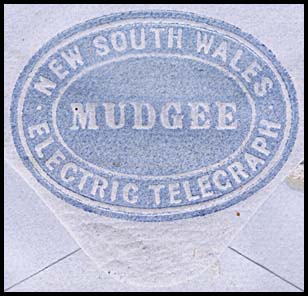 Scan of embossed oval on flap of envelope. Provenance: De La Rue Archives, Gundersen, Johnstone Collection. |
|
|
||
| No special date stamps were issued to Mudgee for use with telegraph work. Instead the usual postal date stamp was used on telegrams. | |||
|
|
||
A Telegraph Office was opened at Mudgee Railway Station on 14 September 1894 and it closed in 1915. It was reopened at a date unrecorded but closed again on 31 December 1955. The Mudgee Guardian of 16 March 1900 reported that "it has been decided to connect the Mudgee Show Ground by telephone/telegraph with the local Post Office, and the necessary authority of His Excellency, the Lieutenant Governor, and the Executive Council has been applied for to charge at the rate of 6d for the first ten word for messages transmitted to and from the Show Ground and the Post Office". |
| Mungindi.
The Mungindi Telegraph Office was opened on 28 November 1881 and merged with the Post Office on 1 February 1882. The Post Office had opened on 1 April 1867. Mungindi is 780 km from Sydney.
|
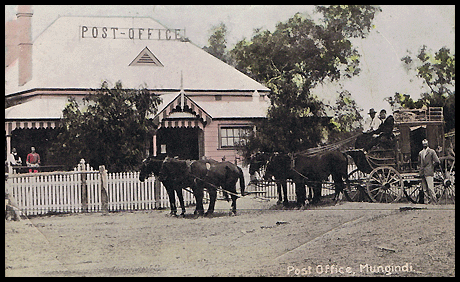 |
||
Being right on the NSW-Queensland border, Mungindi was singled out as an example of the problem of having special "border rates" for telegram charges. In a debate in the House of Representatives on 24 October 1935, Mr. Nock (Country Party, NSW) said that "the normal 9d rate for 15 miles should not be barred by a State border. The (interstate) charge of 1/4 for telegrams sent just across the or from Wahgunyah to Corowa was unreasonable. At Mungindi (Queensland) people had to cross the border to the Post Office on the New South Wales side of the river and pay 1/4 to send a telegram back into their own district".
|
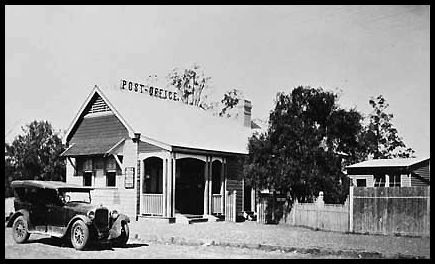 Mungindi Post & Telegraph Office about 1920. |
|
The Post Office had opened on 22 March 1860 when it changed its name from Merrimboolla which had been opened about two months previously on 1 January 1860. This change was made on account of the similarity of the previous name to an existing post office. A Post Office was also opened in Harden on 1 January 1870 -- about 1 mile east of Murrumburrah. The two places are now regarded as a twin town. In the Yass Courier of 6 December 1870, the Murrumburrah Correspondent notes "By-and-by, I dare say the Government will erect a court-house here but I doubt if it will be in my time. A Telegraph Station would also be a desirable thing as also some other matters — a bank and so forth". On 4 February 1876, the Yass Courier reported on a meeting of 17 January with the Postmaster-General and a deputation representing Murrumburrah: "The delegation explained the absolute necessity for the speedy erection of Post and Telegraph offices at Murrumburrah and in close proximity with the business portion of the town. The deputation, with Mr. Watson as their foreman, were received in the most courteous manner by the hon. Minister and the request granted. Prior to leaving, the hon. the Postmaster-General desired to know tho most suitable material for the construction of these works. He was informed that brick was the most available. He then promised to have tenders called for at once and the building would be occupied by a qualified officer to act as Post and Telegraph stationmaster". The Burrangong Chronicle of March 1876 noted "The Government have rented two rooms in Mr. Johnson's house for the telegraph office. The situation is most central, and equally suitable as the cottage on the opposite side of the street, which was placed under offer to the Postmaster-General by Mr. Dillon, when in Sydney, who, your readers will remember, formed one of the deputation to the Ministers to lay before them our local wants. It is generally expected that the telegraph line will be completed within a month ; some delay has been occasioned by the extreme difficulty of obtaining suitable posts for the line". The Telegraph Office was opened by Mr. A. Tucker "in lively style' on 26 June 1876 in temporary accommodation. By the following Saturday, it was reported that "The operator is kept pretty busy and the office seems likely to pay handsomely". The Yass Courier of 14 March 1876 reported inter alia the following letter to the Editor: "In your issue of the 8th inst. appears a paragraph from a Murrumburrah correspondent, in which my name is prominently brought forward in connection with the telegraph office here. I trust you will allow me space to say a few words on the subject. The writer of the paragraph says that the situation of Mr. Johnstone's two rooms, just rented by Government, is most central (to which I have nothing to object) and "equally suitable as the cottage on the opposite side of the street, which was placed under offer to the Postmaster-General by Mr. Dillon when in Sydney who, your readers will remember, formed one of the deputation to the Ministers, to lay before them our local wants". The writer must have a very poor idea of suitableness of premises for Post and Telegraph offices, when he states that Mr. Johnstone's two rooms— with calico partitions, in a little public-house, unenclosed by fence or otherwise — are as suitable for the purpose as my cottage standing, as it does, on a quarter-acre of ground, closely paled in, with a double gate entrance, and completely isolated from other houses. The cottage comprises four moderate sized rooms, with passage through to the back. There is also a good kitchen attached (nearly new), and it has a good well of water. Now, it is well know, or ought to be, that the Post and Telegraph departments demand the strictest privacy, and any one may imagine the sort of privacy obtainable in the two rooms just rented from Mr. Johnstone ... John Dillon". On 18 August 1876, the following was printed in the Yass Courier "Respecting the Post and Telegraph office, I believe the townsfolks have been over-anxious of late. It is a sort of double-barrelled affair: First: There is the paramount necessity of having the building in the town and not at the railway station as once rumoured. It is true our deputation were promised this much but, until we see the work begin, we cannot be sure that this promise will be kept. Upon this point, all the people of the town are at one. The second barrel, however, divides them. In what position shall it be? I hear that there is an official personage in the town now, deputed by the Postmaster-General, to examine and report upon the best site. He condemns the use of the ground at the Police Court. Then there are some other places. Mr. Dillon's cottage has been under offer to Government, it is said, for some time, at a price. Lately a petition went down to the Postmaster-General from the East-enders, in which a convenient vacant allotment was offered to the Government gratis by Messrs. T. and G. Barnes. The allotment in question lies between the stores of Messrs. T. and G. Barnes and Mr. A. Aiken, and is about as central a position as could be had. Mr. Dillon's cottage also lies in a good position. But perhaps the railway station, after all, is to be the place and Murrumburrah will have to follow it". In August 1876, the Appropriations Bill for the year allocated £800 for the erection of a Post and Telegraph Office at Murrumburrah. Tenders were called in March 1878. The new Post and Telegraph Office was opened on 16 June 1879 by Mr. Tucker - Inspector of lines and stations (at a place yet to be confirmed). People of the town were pleased with the building. In May 1892, a tender from Mr. S. Ford was accepted for the construction of a Post and Telegraph Office at Harden to be completed in seven months. Personnel: By 30 December 1876, the Evening News highlighted that staffing problems were already an issue: "We understand that considerable inconvenience is experienced at Murrumburrah, in consequence of the want of a messenger at the local telegraph office. In cases of messages arriving, the station-master has to deliver them himself, and the office is shut up while he is running about with them". June 1876: Mr. Harold Norrie, the Assistant Operator at Mudgee, was transferred to be Telegraph Station Master at Murrumburrah. He was still in charge when the amalgamation took place. December 1879: Mr. H. F. Norrie, Post and Telegraph Master, Murrumburrah, has exchanged his appointment with Mr. W. G. Wilson, clerk in the Crown Solicitor's office. |
|
| Narrabri.
The Narrabri Telegraph Office was opened 8 June 1869 with Mr. R. D. Arnott as the Station Master. It merged with the Post Office on 15 July 1872 - the Post Office having been opened on 1 June 1861. The Maitland Mercury of 2 September 1869 commented: "The telegraph is in full operation and is quite a boon to the people now that our mails depart at such awkward times. We get our Sydney and Maitland letters on Monday and Thursday mornings and the return mail starts out again in a couple of hours which oftentimes makes it awkward to reply by return - hence the use of the telegraph". |
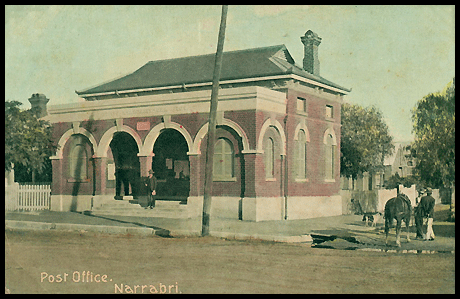 Note: this picture has been printed in reverse!! The enlargement shows the letters of "POST AND ..." on the façade are reversed. |
|
|
||
"A public meeting was held in the Court House on the 20th instant, with the view of remonstrating with the Government against the proposed amalgamation of the office of Postmaster with that of the Telegraph Station master at Narrabri". For those with a keen interest in this region, the report printed in the Maitland Mercury of 29 October 1869 makes very interesting reading. Two points relevant to this description are:
|
||
A steel circular type 2C TELEGRAPHS NARRABRI date stamp (SC1-T) was issued to the Office.
|
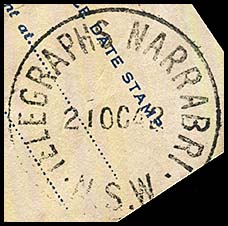 21 October 1942. Used on AB-DO-8H. |
|
| The Narrabri Railway Station also had a telegraph office from 19 February 1883 although over the following 50 years, the name kept changing - Narrabri West, Narrabri West Railway Station as well as the original Narrabri Railway Station. | ||
| Nymagee.
The Post & Telegraph Office was opened on 1 December 1881.
No special date stamp was issued for use with telegraphs. |
| Orange.
The Telegraph Office opened (at the Court House) on 21 December 1860. Orange Post Office opened on 1 January 1849 at a time when the Western Road was served by mail services four times a week. This frequency increased in 1862 when Cobb & Co became responsible for the mail service. Tenders were called for the erection of a single building at Orange in July 1862 containing both a Telegraph Station and a Post Office. The combination was a new policy adopted by the Government. The contract was awarded to William Hale the following month. Combined services with the Post Office commence on 1 January 1870. From that time, the mail service was mainly operated by the railways and Orange was nominated as the terminus in 1877. A new building was designed to reflect that status and to be able to handle the significant demands. The Gazette advertised for tenders to erect a Post and Telegraph Office at Orange in March 1878. The official opening of the new premises in Summer Street was held soon after - the ceremony being held just before noon on 3 February 1880. A large number of newspapers carried the following article in April 1911: "The Wilcannia Council is asklng the co-operation of all Municipal Councils in a united protest to the Postmaster General against the early closing of the telegraph offices. The Wilcannia civic fathers complain the closing of the Telegraph Offices at 6 p.m. is a sham, because the officials have to work after that hour. Commenting on this matter, the "Western Daily Advocate" Orange, voices opinions similar to those already expressed in the "Liberal". Says the Advocate: "As the notice of closing telegraph offices at that hour was issued principally on the behalf of officials. It would seem that the Wilcannia Council is on good ground in making the protest. The public grievance is that the change is retrogressive, that their convenience is subordinate to the convenience of officials who have never asked for the change, and are not convenienced thereby, and that the public have to either not to send telegrams after 6 o'clock, whether they want to or not, or pay blackmail, as in the case of a number of offices - Orange inclusive - by paying urgent rates. Telegrams can be sent from the Orange and other certain offices from 6 pm to to 8 p.m. but only by payment of excessive fees". |
||
|
||
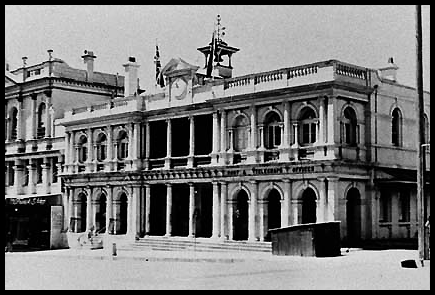 |
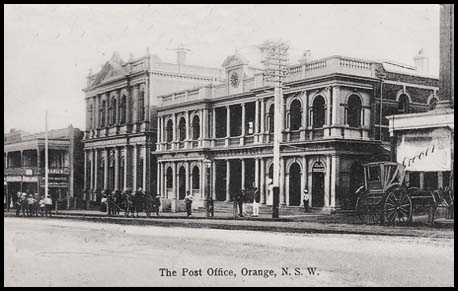 |
|
Personnel: May 1861: Mr. R. Pizey was appointed Station Master. 1871: A young Mr. H. Curry joined the telegraph Service in his 21st year and remained there for five years before being transferred to Goulburn. See the Goulburn entry for further details. |
||
Early usage: There is no early evidence of the operations of the Orange Telegraph Office. The earliest form recorded is a Interim period delivery form (NI-DO-4B) sent from Annandale to Orange on 23 October 1908. The form also has:
|
||
Orange was one of the 29 Telegraph Offices included in the special printings of delivery envelope NC-EO-3. These envelopes incorporated an embossed oval seal (EO6-ET) on the flap of the envelope with NEW SOUTH WALES at the top and ELECTRIC TELEGRAPH at the base. The office name was embossed across the centre of the seal.
|
 Scan of embossed oval on flap of envelope. Provenance: De La Rue Archives, Gundersen, Johnstone Collection. |
Date stamps: A steel circular TELEGRAPHS ORANGE type 2C date stamp was used at Orange with two formats. |
||
|
|
|
|
|
|
| The usual post office date stamps were also used on telegrams in Orange. See also the form above. | 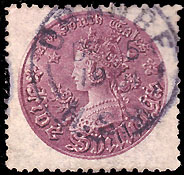 5 December 1901 Used on 5/- coin stamp design commonly used to pay higher value telegram costs. Date stamp type 1D (i). |
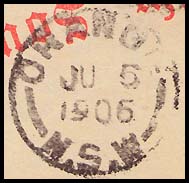 5 July 1905. Diameter: 24 mm. |
A Telegraph Office was also opened at Orange Railway Station on 14 September 1894. It closed on 30 December 1970. A date stamp for the Station is recorded in 1955. |
||
|
The telegraph line was connected to Parkes on 17 March 1875. The Evening News of 20 March 1875 noted "At last we have the Telegraph Office at Parkes and I must say it is a disgrace to the department. It is surely criminal in any Government to leave such an important district as ours so utterly neglected as the late one has done. I think this is the only goldfield in the colony that has gone on steadily increasing its yield for more than three years and in the last year it has more than doubled its yield of the previous year and has every appearance of maintaining its present yield for three more years". Parkes Post Office opened as Bushman's Lead on 1 August 1872 and changed name to Parkes on 1 December 1873. The Post Office had been established in response to the demand for postal facilities from those searching for gold in the surrounding area. Mail originally come via Forbes but, when Cobb and Co took over the mail coach run in 1882, Parkes was in contact with both Forbes and Orange. In November 1874, the Post Office was still located in a public house which presented a great inconvenience to the people for many reasons. The establishment was upgraded to a Post & Telegraph Office on 1 April 1875. The Empire of 2 December 1873 reported about the condition of Parkes: "I see the postal authorities have withdrawn the tenders for a mail to this town via Murga so that the Government will have to give us the mail as asked for. I hear that the works department have determined on adding two small rooms to our court-house, lock-up and police barracks. There are but four rooms altogether, which are used as court-room clerks-office, magistrates-room, police-barracks, dining-rooms, prisoner's cells, etc. Now that nothing short of a separate building for a court-house will suit us, and the proposed two rooms will be a useless expense if the population that is located on this place do not deserve a court-house, a separate mail direct from Orange, and some attention to our roads and bridges. It is high time that some inquiry was made as to how much public money is being spent on some places of much less importance than this. Only fancy a gold-field maintaining a population from 3,000 to 6,000, for two and a-half years being without any Government buildings except a four-stall stable and a lock-up and court-house as described above. No post or telegraph office, nor bridges, except those erected by private individuals. Surely under such a state of things we cannot be said to live in the age of progress". About the time the telegraph line was connected to the public house, the Austalian Town and Country Journal 6 March 1874) informed its readers "The Telegraph Master has been here for the last fortnight but no apparatus has yet come to hand. Great indignation is felt against the department. The apparatus was sent away several weeks ago but, through difficulty in obtaining carriage, it has been delayed on the road. It is expected to arrive at Parkes today". As usual, discussions continued. The Australian Town and Country Journal of 26 June 1875 reported "The postal inspector, Mr. Buchanan, paid us a visit last week. A number of gentlemen waited on him to show him the necessity of establishing a mail between here and the Bogan River and another to Condobolin on the Lachlan River. And from the rate at which the land along both these routes is being taken up, I fancy the inspector will strongly recommend both. A site for a new Post Office was also recommended but it appeared to be the opinion of the inspector that the Government would erect the Post and Telegraph offices on the reserve near the court-house. But if the government consider the public in the matter, they will build it in the front street. A Post and Telegraph office should, in my opinion, be in the most central position obtainable. More particularly so in a town such as ours, where there are such long stretches without cross streets". |
|
|
|
|
|
During a severe thunderstorm in February 1878, "the lightning was fearful, the electric fluid flying about in every direction. One fireball burst near the Telegraph Office (in the public house), some portion entering the office, singeing the wood work and destroying a considerable quantity of the wire". On 7 September 1878 - only about 3½ years after the telegraph line had been connected to Parkes the Australian Town and Country Journal was able to report: "Great joy was apparent when news came to hand that tenders for the erection of new Post and Telegraph offices were called. The site will be on the Government Reserve, contiguous to the court- house. There has been some bantering between opposing parties as to the best site; probably the greater number were inclined to a more central position in the town but are satisfied with any locality rather than wait longer for it". The Government wins again. Another community ground down to acceptance!!! On 28 June 1884, The Sydney Mail reported on the discussion in a special meeting of Parkes Municipal Council. In part: "Alderman Lowing asked if it would not be advisable to request the Government to replace the telegraph poles (which are to be removed from Forbes Street into Currajong Street) with iron poles He was informed by the Mayor that it was against the rules of the Telegraph Department to supply iron poles to country towns". |
|
Personnel: May 1876: Mr. Frederick J. Colls, a probationer in the Electric Telefraph Office at Yass was transferred to be Junior Operator at Parkes. February 1883: Mr. John Park, Telegraph Operator at Parkes for many years, was transferred to Moss Vale to be Station Master. His place was filled by Mr. Neil McIntosh from Moss Vale. June 1883: Mr. John Buckley, messenger at Mount Victoria was transferred to be an operator at Parkes in lieu of Mr. Neil McIntosh who was dismissed. March 1900: Mr. John Buckley, Operator at Parkes was promoted to be Telegraph Master at Raymond Terrace. July 1925: Mr. Ernest Jones, telegraph linesman in Forbes for a number of years, was last week transferred to Parkes. He is a married man and will be making his home here in the near future. No special date stamps were ever issued to Parkes for use with telegraphic work. |
|
| Peak Hill.
The Post & Telegraph Office opened on 31 July 1890. The Molong Express of 29 March 1890 alerted its readers as follows: "If any of our local capitalists contemplate tendering for leasing to the Government a building to be used as a Post and Telegraph Office at Peak Hill, we would remind them that tenders close at 11 a.m. on Wednesday next, the 2nd April". |
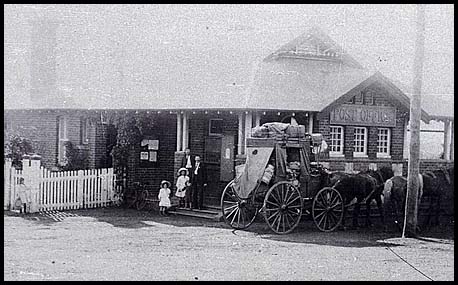 Peak Hill Post & Telegraph Office about 1910. |
The Australian Town and Country Journal of 7 June 1890 reported: "The new premises that are being erected for use as Post and Telegraph offices are nearing completion and the building occupying, as it does, the best position in the town, has a very imposing appearance". A description of the size of the goldfield is given in the Evening News. Personnel: June 1891: The Peak Hill Times of Friday, June 12th, says: "Although everyone will regret losing Mr. P. Brown, who has been Assistant Postmaster here since September 1 last, they will be pleased to know that he has been promoted, and left this morning to take up his duties as Post and Telegraph Master at Alicktown. Mr. Brown came here from Molong and during his stay has made himself very popular both in his business capacity nnd otherwise. We believe we echo the sentiments of the residents of Peak Hill when we wish him every prosperity in his new quarters. Mr. Clifford from Forbes succeeds Mr. Brown". |
|
|
|
|
Penrith served as a meeting point for the Northern line to Queensland and for the line to Bathurst. The lines had actually been completed through Penrith in the middle of 1859 but it took until 23 March 1860 before the Telegraph Office opened and communication to Sydney for the public established. Even then, the office was placed in the Court House on a "temporary basis". A Post Office had been opened at Penrith on 1 March 1828. In November 1878, a tender was accepted from Mr. P. Graham for the erection of a Post and Telegraph Office at Penrith. On 29 September 1899, this Office together with other facilities, was converted to a Post & Telegraph Office. Personnel: May 1867: Mr Alfred Tunks, now Station Master and Line Inspector at Forbes, was appointed Station Master and Line Inspector at Penrith. Mr William McIlrick, junior operator at Penrith was transferred to Sydney to be Battery Man. May 1867: Mr James H. Craig, Junior Operator at Tamworth was transferred to Penrith to be Junior Operator.
Many of the people who work in the telegraph offices have varied interests outside of their employment - just one example is Mr. E. H. Matthews on the Yorke Peninsula. But Penrith had its own: "The climate of this colony has been repeatedly noticed as being favourable to the growth of the mulberry tree and the cultivation of silk but, with the exception of a few worms kept merely as objects of curiosity, little has been done to promote so desirable an industry. We are glad to learn that silk growing on an extensive scale will shortly be introduced, through the enterprise of Mr. Croft of the Telegraphic Department, Penrith, who intends planting five acres with mulberry trees and also obtaining a stock of the best description of worms" (Illustrated Sydney News 16 July 1864). Unfortunately no production data can be located but, when it is, it will included in a future update of this site. January 1863: Mr. Thomas G. Croft, a Booking Clerk in Sydney, was appointed Station Master and Line Inspector. January 1868: Mr. George U. Hoskings was appointed as an Operator in the Electric Telegraph Office. |
|
A rubber circular TELEGRAPHS date stamp (RC1 - T) was issued to the Office:
|
 1 November 1979. Used on AT-DO-15A. |
|
Penrith served two roles:
The first sod on the Blacktown-Penrith railway line was turned on 6 July 1859. The Telegraph Office opened at the Railway Station on 28 March 1860. In November 1860, it was decided that the office on the Northern line of Telegraphs would be that at the Railway Station. This Office was reclassified as a Telephone Office (retaining telegraphic operations) on 28 May 1934. It was closed on 31 October 1960. |
|
A steel circular PENRITH RAIL (SC1-Rail - H&T type 2A) date stamp was issued to the Office:
|
 No date. Used on a telegram AW-TO-10Ca. |
|
In the Legislative Assembly of 22 February 1878, Mr. Sutherland answer a question to the effect "Tenders for a Post and Telegraph Office at Rockley would probably be invited un the course of the next few weeks. The matter of a site was being considered". On 26 April, 1878, Mr. Burns, in answer to a question, said that "the plans etc for the Post and Telegraph Office at Rockley would be ready in about six weeks when tenders woud be invited for the work. The delay had been caused by difficulty respecting the site". The tenders were called in August with a closing date of 27 August 1878. In September, the Gazette announced that the tender submitted by Mr. A. G. Stanger had been accepted to construct a Post and Telegraph Office at Rockley. On 1 October 1879, in the Legislative Assembly, Mr. Burns, in a reply to Mr. Pilcher, said tenders had been accepted for the Post and Telegraph Office at Rockley and that the work was being proceeded with. The Telegraph Office opened on 13 September 1879. It merged with the Post Office in new premises on 5 May 1880. The Sydney Morning Herald of 10 May 1880 noted: "The new Post and Telegraph offices were formally opened here to-day (Saturday 8 May) by Mr. C. E. Pilcher, member for West Macquarie. Mr. A. Budden, as chairman of the Public Banquet Committee, sent a message expressing pleasure, on behalf of the inhabitants, that Rockley had been connected with the telegraph system of the colony, and a reply was received from the Sydney office, offering congratulations. After the offices had been declared open, the company, to the number of about 40, proceeded to the Costello Club-house Hotel where a banquet was held; Mr. Budden was in the chair, and near him were Messrs. Pilcher, T. H. Hellyer (the Mayor of Bathurst), G. H. Reid, W. G. Thompson, and others. Various toasts were proposed and responded to, and congratulatory speeches delivered. The banquet was quite a success. The new building is substantially built, prettily situated, and is admirably adapted to the purposes for which the offices were built". |
|
In the Assembly, on 13 June 1876, Mr Burns, in answer to a question from Mr. Hurley (of Hartley) said there did not appear to be sufficient business at Rylstone to warrant the construction of a Post and Electric Telegraph Office there. Soon affer, on Friday 11 August 1876, a resolution in favour of the appropriation of £800 for the erection of a post and telegraph office at Rylstone was agreed to, on the motion of Mr. Hurley. In answer to a question in the Legislative Assembly of 1 February 1878, it was stated that "As soon as the site for Post and Telegraph Offices at Ryalstone was determined, tenders for their erection will be called for". |
|
Tambaroora is near Hill End. Gold was found there in 1851-52. In the 1861 Census, the population was 2,235 of whom 1,625 were Chinese. A Post Office was opened on 9 July 1852 with Brinsley Guise Sheridan as Post Master.. A building was rented from T. Peters in 1862 for the Office. In January 1861, W. J. Slack became Post Master. The Telegraph Office was to open within the week of 7 September 1862 according to Mr. Arnold in the Legislative Assembly of 4 September but the final date was 3 October 1862. That was about 9 years before the Telegraph Line was opened at Hill End. The Office was upgraded to a Post and Telegraph Office on 1 January 1870. The Post Office was closed on 31 March 1923. See more details and great pictures of Tambaroora and the 1872 image of the telegraph office in Tambaroora (its # 14 on the list) along with all the other great pictures from the Mitchell Library!!! Note the knots in the telegraph pole. |
|
A Post Office had been opened at Trangie on 16 March 1883. A combined Post and Telegraph Office was opened on 1 August 1887. The telegraph line from Narromine to Nyngan passed through Trangie. Nevertheless, the Evening News of 17 November 1887 carried the story that "The Postmaster-General's proposal to remove the newly-erected Post and Telegraph Offices at Trangie is being indignantly opposed by the residents of the town". After 3½ months of operation?? |
|
The Telegraph Office was opened at Trundle Lagoon on 18 January 1892. A congratulatory message was sent to the Postmaster-General from the Progress Committee. The Office changed name to Trundle on 11 July 1892. |
|
Personnel: 2 May 1889: Miss M. T. Moloney was in charge of the Post Office which opened on that date. July 1892: Mr. S. C. Francis was the Post & Telegraph Station Master when the office changed name. He was transferred on 1 August to take charge of Millthorpe Station and was replaced by Mr. McFadden from Katoomba. 31 July 1896, the Sydney Stock and Station Journal reported that "Mr. J. McFadden, our genial Post and Telegraph Master, has just returned from a three weeks holiday and Mr. Bilton, of Orange, who was relieving him, left on Saturday". |
| Warren.
The Telegraph Office opened on 26 October 1876 and merged with the Post Office, which had opened in 1861, (unsure of date as Hopson & Tobin confused). |
|
|
A town called Wyalong was established in 1884 well after a change of name to Barmedman in another location much further to the south. Gold was discovered in the new location in 1893 and the main town was established to the east of the diggings at the place referred to as Wyalong (or, in 1894, as Wyalong Township). A Receiving Office was opened there on 18 April 1894. Two months later, on 22 June 1894, a Post and Telegraph Office replaced the Receiving Office and there was a name change from Wyalong Township to Wyalong. |
|
| In 1895, a settlement called West Wyalong was established to the west around a bullock track. As mining declined in Wyalong (Township), agriculture developed around West Wyalong. There was intense competition between the two settlements - even to the stage that when the railway line was constructed to the area in 1903, the station had to be placed midway between the two places - less than two miles from each - at Wyalong Central.
A Post & Telegraph Office was opened in the western township (then also called Wyalong) on 11 June 1894 but it changed name to West Wyalong 11 days later on 22 June (see picture). So there were two Post and Telegraph Offices within three miles of each other. |
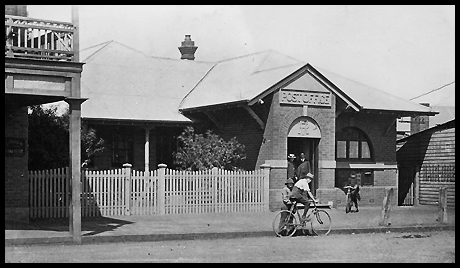 West Wyalong in the late 1890s. |
| On 15 August 1894, the Wyalong Progess
Committee held a meeting to discuss and advocate certain issues - amongst which they urged for the reduction of telegram rates between Wyalong and West Wyalong to 6d.
Personnel: July 1894: Mr. W. Layton was appointed as the Post and Telegraph Master at West Wyalong. March 1895: Mr Percy Kingsford was promoted to West Wyalong from Cowper (NE of Grafton). |
|
|
|
Young (Lambing Flat/Burrangong). Burrangong was a 100 square mile station established in 1826. On that station, some stockmen were searching for horses in mid-June 1860 and camped near a creek called Lambing Flat. While relaxing, they washed some dirt and found gold. By the end of July 1860, a gold rush had begun. The Post Office at Lambing Flat had opened on 1 March 1861. In 1863, Lambing Flat was renamed Young. The Burrangong Shire became a local government area in NSW. In 1906, the Council Offices for the Burrangong Shire were located in Young but Young was not part of that Shire. All problems were finally solved in July 1980 with the Burrangong Shire being amalgamated with the Young Shire. A glimpse of the life at Lambing flat and the nearby diggings at Burrangong is given in the Goulburn Herald of 23 February 1861 and the Sydney Mail of 3 August 1861. At a time of most significant population increases due to the gold-finds (to over 12,000 people) and the Lambing Flat anti-Chinese riots, The Empire of 5 August 1861 published the following: "The Postmaster here, Mr. Butchart, gets £12 a year. From daylight till midnight, his energies are taxed to receive and deliver mails. The place is like a fair all the day long. It would be impossible for him to get through the work without the assistance of the members of his family and others. This state of things ought to be altered immediately. What we want here is a police-force, which should include four or five detectives under an efficient head. We also want a court-house, with a stipendary magistrate. In addition to these things, we ought to have lines of telegraph to Yass and Bathurst".
On 10 April 1862, Mr. James Moore's tender to erect a Telegraph Office at Lambing Flat was accepted - a long time before the telegraph line reached Young from Wagga Wagga. In the Legislative Assembly on 16 July 1862, one question was answered with "it was the intention of the Government to proceed with the erection of Post and Telegraph Offices at Young (Burrangong) in fact that tenders had been accepted; that it was not, however, intended to erect those offices on Government ground but on a more suitable site offered by a private individual". Later that individual was identified as being Mr. Pritchard. On 23 January 1863, the name of the Post Office was changed from Lambing Flat to Young. The Post Office and Telegraph Office also merged on that date. In the Legislative Assembly of 13 January 1864, "Mr Garret asked the Secretary for Public Works:
Mr Holroyd said there was no money voted for a Post Office at Young but the Colonial Architect was preparing a plan and estimate of a Telegraph Station at that place. In regard to the second question he might state that tenders were invited by the previous Government for the erection of a Post Office and Telegraph Station at Young, but the lowest tender was in excess of the estimate. Besides the money for the Post Office (on the supplementary estimates for 1863) not having been voted, tenders were declined". In March 1864, plans were submitted for a telegraph station at Young and a contract had been taken by mid April 1864. The Post and Telegraph Office opened on 4 July 1867. In a wonderful article about the "unsensational life" in Burrangong (quite distinct from the anti-Chinese riot years), the Mining Record of 15 June 1867 commented on the Post and Telegraph facilities: "The removal of the Post Office to the shop lately occupied by Mr. Hodson, chemist, has been effected after some slight opposition on the part of some of our town people. The new office is quite as central and affords more convenience for the despatch of postal duties than the old one, but I should think a more suitable place could have been found than a mere shell of weatherboards attached to other premises of a similar construction and divided from them only by calico and paper walls. The Postmaster, who lately succeeded Mr. Macarthur in the office, was last week suspended. The only charge against him, so far as I can learn, is neglect of duty and, if report speaks truly, when the authorities here took possesion of the office after his suspension, it was in an admirable state of confusion. Mr. McGuiness, of the Telegraph Office, is at present discharging the duties until an appointment is made by the Postmaster-General". There was however a much more critical and sad under-current to this story. Tenders called for the "Erection of a Telegraph Station at Young" closed on 15 July 1873. In August 1876, the Appropriations Bill for the year allocated £2,000 for the erection of a Post and Telegraph Office at Young (and £8,600 for a gaol). |
|
|
|
|
January 1863: Mr. W. Wilson was transferred from being Station Master at Yass to be Station Master at Young. January 1863: Mr. F. Mackel, the Line Inspector at Bathurst, was transferred to be Line Inspector at Young. March 1876: Mr. S. Cunningham was appointed Junior Operator in the Telegraph Office. May 1881: Mr. D. J. Elliott, a junior operator at Young was promoted to be Station Master at Burrowa. January 1883: Mr. A. Muir was transferred from being Station Master at Moonbi to be Operator at Young.
December 1928: Mr. Jack Muldoon, who had, for many years been in charge of the Telegraph Section of the Young Post Office, was appointed to the position of Postmaster at Henty. |
|
|
No special date stamps were issued to Young for use with telegraphs. |
|
| A Type 1A date stamp, which has been used for postal purposes between 1867 and 1880 was used on telegrams between 1910 and 1914. |  Young postal date stamp. 15 December 1941. Cancelling a McCracken imprint block of 4 and with a slogan cancel for: Happy Thoughts ! Christmas and New Year Greetings by Telegram. |


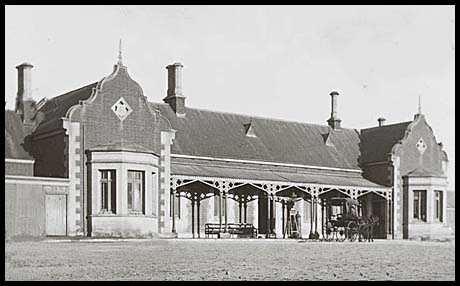
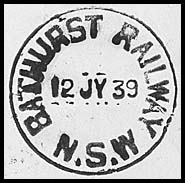
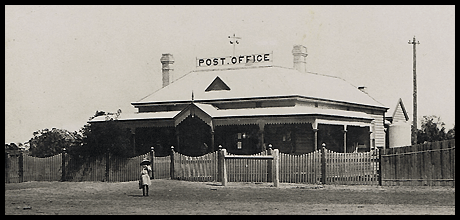
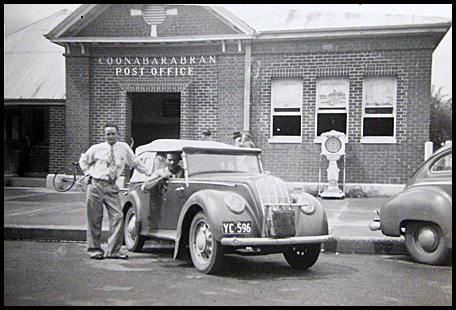
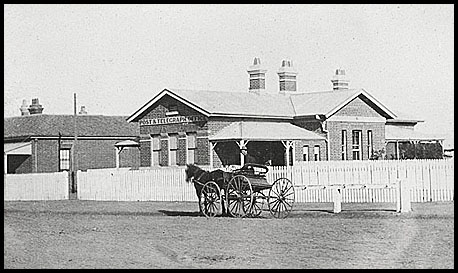

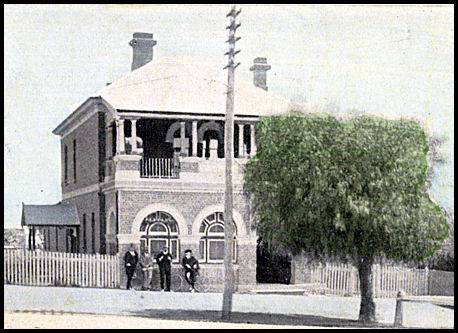


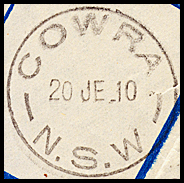



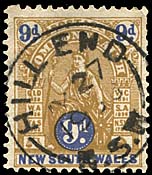
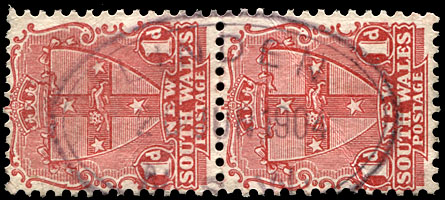




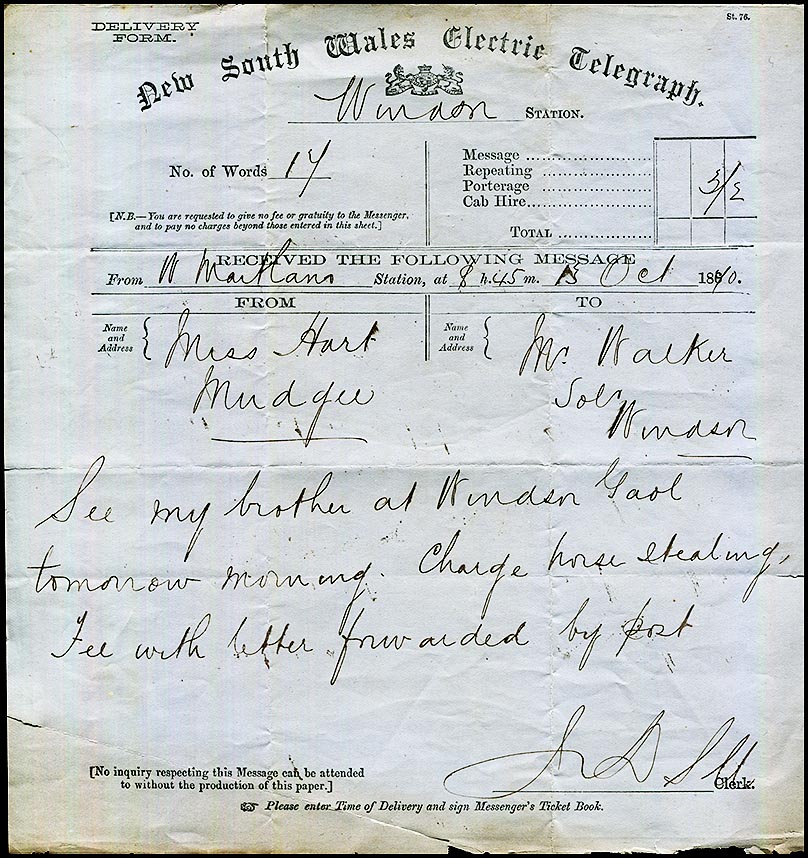

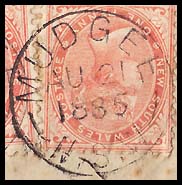
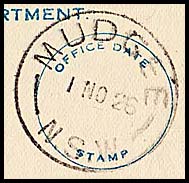




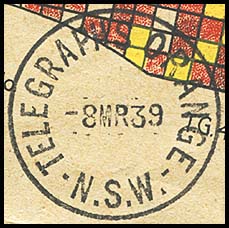
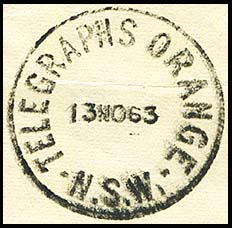

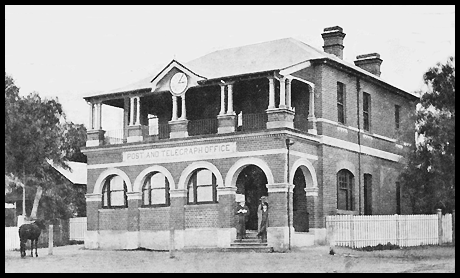

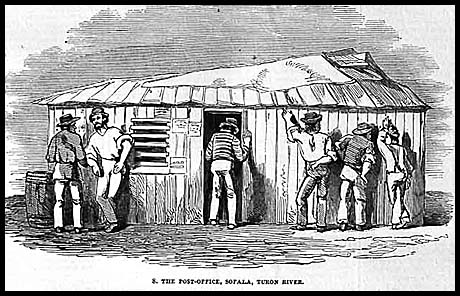




 .
.

